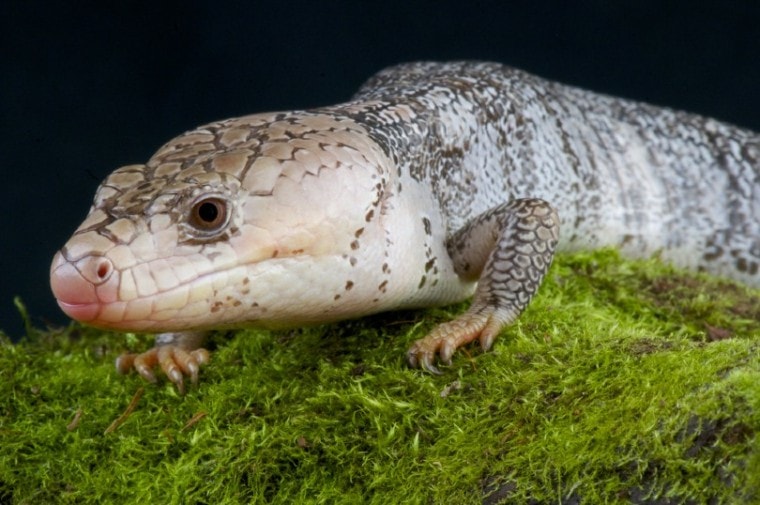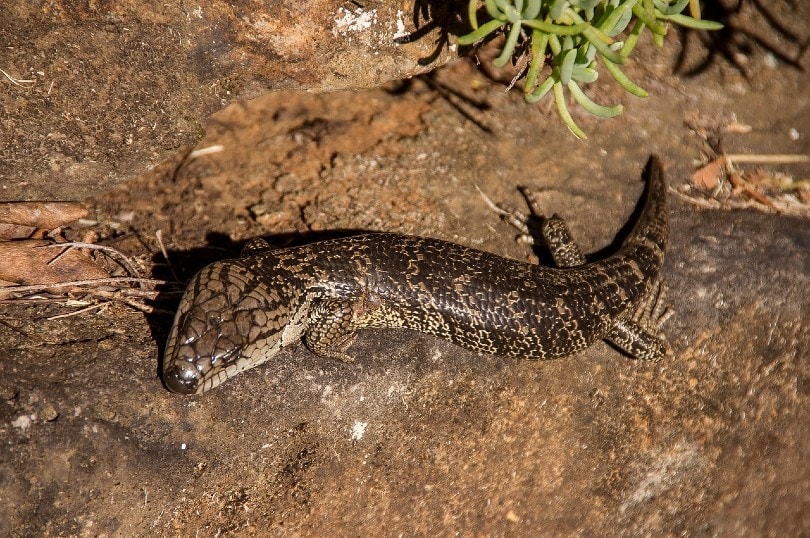
If you’re looking for an easy-to-take-care-of lizard, the Pink-Tongued Skink is an outstanding choice. They have a long lifespan, are extremely hardy, are easy to breed, and more! But what else do you need to know about these critters before adopting? We break it all down here.
Quick Facts About Pink-Tongued Skinks
| Species Name: | Hemisphaeriodon gerrardii |
| Common Name: | Pink-Tongued Skink |
| Care Level: | Low level/beginner |
| Lifespan: | 20 years |
| Adult Size: | 18” |
| Diet: | Worms, bananas, mice, cat/dog food, chicken, and beef |
| Minimum Tank Size: | 10 gallons |
| Temperature & Humidity: | 70 – 80 degrees Fahrenheit, a basking area of 90 degrees Fahrenheit, and 70-80% humidity |

Do Pink-Tongued Skinks Make Good Pets?
If you’re looking for a low-maintenance lizard that is great for beginners, the Pink-Tongued Skink might be precisely what you’re looking for. They have a mild temperament that allows for a decent amount of handling, but you need to be careful of their sharp claws. While they don’t use them much, if you push your Pink-Tongued Skink, you might have an uncomfortable experience. But with a bit of training and time, you can handle this laidback lizard with ease, and maintenance for these friendly reptiles is minimal.
Appearance
Most Pink-Tongued Skinks look incredibly similar. They have a body color that ranges from a silvery gray to a light-brown color. They also have dark-brown or black stripes that run down their body.
While adults have a pink tongue and it’s what gives them their name, babies have black tongues that change colors as they grow. Overall, this is a slender lizard with a wide head and sharp claws that you need to be wary of when handling.
How to Take Care of a Pink-Tongued Skink
Habitat, Tank Conditions & Setup
Tank
While the minimum tank size for a single adult Pink-Tongued Skink is 10 gallons, there’s little doubt that a larger tank will make for a happier pet with more room to roam. In fact, if you can get a tank between 20 and 30 gallons, you’ll be in far better shape.
No matter which size tank you use, ensure that it has a tight-fitting top so your Pink-Tongued Skink can’t escape. These gentle lizards love a good challenge, and nothing is more exciting than trying to escape their enclosure!
You need to do a thorough cleaning of the tank at least once a week, but you need to clean out the water bowl daily to keep your pet healthy.

Lighting
While Pink-Tongued Skinks don’t have any specific lighting requirements, an extra UVB light on one of the tanks is a good idea. If you combine it with your heat lamp, you won’t even need an extra bulb in your tank!
Heating (Temperature & Humidity)
The Pink-Tongued Skink is cold-blooded, like reptiles, so it’s essential to set up a temperature gradient inside their tank. You’ll need a heat lamp on one side of the tank that consistently keeps the temperature between 80 and 90 degrees Fahrenheit.
However, on the other side of the tank, the temperature shouldn’t sink below 70 degrees. As far as lizard enclosures go, this is relatively easy to set up.
Your Pink-Tongued Skink needs a high-humidity tank to stay healthy. A humidity level between 70% and 80% is ideal. To help with this, leave a full bowl of water in the tank at all times and mist your Pink-Tongued Skink tank a few times a day.
Substrate
You Pink-Tongued Skink needs an enclosure that matches their wild habitat as much as possible. They have leaf litter and tons of places to hide in the wild, and that’s what you want to match in the tank. Cypress mulch is an excellent choice for this, but it’s up to you.
Tank Recommendations
| Tank Type: | 20 – 30 gallons is ideal |
| Lighting: | UVB light |
| Heating: | Heat lamp between 80-90 degrees Fahrenheit, adequate space to cool off, and a humidity level between 70% and 80% |
| Best Substrate: | Cypress mulch |
Feeding Your Pink-Tongued Skink
For young Pink-Tongued Skinks, you need to feed them every other day, but three times a week is sufficient for adult lizards. Never feed your skink more than they can eat in one session.
However, there’s no set amount of food that you should feed them — simply remove the extra food after they’ve finished eating.
Pink-Tongued Skinks have a varied diet and can eat earthworms, waxworms, mealworms, crickets, bananas, mice, cat food, scrambled eggs, mango, raspberries, chicken, beef, and more! It’s best to feed them a varied diet, so mix it up as much as you’d like — just be sure to sprinkle in a healthy dose of live insects.
Diet Summary
| Live Insects: | 70% |
| Fruits: | 15% |
| Chicken, Beef, Eggs, and other food: | 15% |
Keeping Your Pink-Tongued Skink Healthy
As far as lizards go, Pink-Tongued Skinks are a relatively hardy breed. Still, you need to keep an eye on your pet to see if you notice any abnormal behavior. If your lizard appears more lethargic, has extra mucus, has a loss of appetite, or has skin problems, it’s time to seek out a vet.
These aren’t problems that will typically clear up on their own, so finding a vet with a thorough understanding of exotic animals is essential to getting your Pink-Tongued Skink back on track. We highlighted a few additional potential health problems to look out for in your Pink-Tongued Skink here.
Common Health Issues
These include obesity, scale rot, respiratory infections, parasites, and mites.
Lifespan
If you take care of your Pink-Tongued Skink properly, there’s no reason that your lizard can’t live between 15 to 20 years. However, this all depends on the quality of care that you give them, including an adequate-sized tank.
While these lizards are great for beginners and can tolerate a few mistakes, those mistakes can still shorten the life of your Pink-Tongued Skink over time. So, be sure to learn from your mistakes, and you should have a lizard for a long portion of your life!
Breeding
Unlike most lizards, Pink-Tongued Skinks have live births! If you’re looking to breed your Pink-Tongued Skink, it’s a relatively easy process. Ideally, you should have multiple females and males in the same enclosure, so make sure you have enough space for all of them.
Females have a gestation period of just over 100 days, and they’ll give birth to anywhere from five to 67 neonates! A typical litter consists of 10 to 20, and you should move them to individual cages as soon as possible to prevent issues.
However, keep in mind that the mother will eat their afterbirth within minutes of giving birth, so don’t move her before she’s completed this. Each neonate is born one at a time, with just a few minutes separating each birth.
Since breeding is easy, you will need to keep this in mind if you’re housing multiple Pink-Tongued Skinks and don’t want a tank full of babies!
Are Pink-Tongued Skinks Friendly? Our Handling Advice
Pink-Tongued Skinks are incredibly mild-mannered and docile. They don’t mind you holding them, but it’s best to slowly increase the amount of time that you hold them. This will give them more time to adapt and get used to it.
When your Pink-Tongued Skink shows signs of agitation, it’s best to put them back in their enclosure instead of forcing a longer interaction. They do have sharp claws, and while they don’t use them often, if they decide to, it can certainly hurt.
Still, these are beginner pets for a reason, so you should be able to hold them and walk around with them eventually!
Shedding & Brumation: What to Expect
A Pink-Tongued Skink will shed their skin from time to time, and a high-humidity environment will help with this. Keeping the water bowl slightly overfilled to moisten the substrate around it will help too!
When winter comes, it’s best to slightly lower the temperature of the tank over time. Do it only 1-2 degrees at a time every few weeks, and never go below 60 degrees. This will help match winter conditions in the wild.
It is usual for your Pink-Tongued Skink to become slightly more lethargic during this time, but they should still have a bit of energy. Finally, when winter is over, bring the temperature back up a few degrees every few weeks instead of warming the tank immediately.
How Much Do Pink-Tongued Skinks Cost?
A Pink-Tongued Skink usually costs between $250 and $300. While this is a little expensive, they are a larger lizard and have a longer lifespan, which helps offset the cost.
When you factor in the enclosure, food, and everything else that you’ll need, you can quickly expect to spend more than $1,000 in the first year.
Final Thoughts
If you’re interested in reptiles but have never owned one before, a Pink-Tongued Skink is ideal for beginners. But keep in mind that they’re not a short-term investment, as they can live for up to 20 years! As pets, they are easy to take care of and don’t mind handling, making them a great starter reptile!
Featured Image Credit: reptiles4all, Shutterstock








